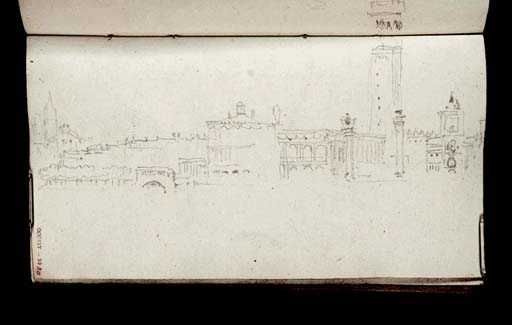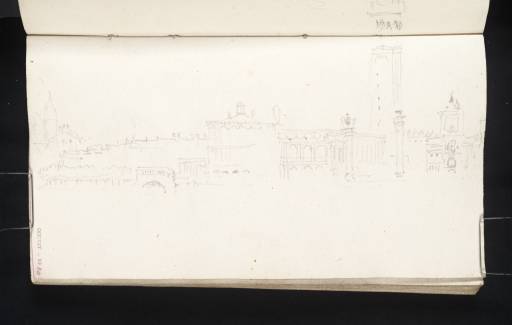Joseph Mallord William Turner The Giardini Reali, Zecca, Libreria Sansoviniana and Piazzetta from the Bacino, Venice, with the Campanile of San Marco (St Mark's) and the Torre dell'Orologio Beyond 1833
Image 1 of 2
-
 Joseph Mallord William Turner, The Giardini Reali, Zecca, Libreria Sansoviniana and Piazzetta from the Bacino, Venice, with the Campanile of San Marco (St Mark's) and the Torre dell'Orologio Beyond 1833
Joseph Mallord William Turner, The Giardini Reali, Zecca, Libreria Sansoviniana and Piazzetta from the Bacino, Venice, with the Campanile of San Marco (St Mark's) and the Torre dell'Orologio Beyond 1833 -
 Joseph Mallord William Turner, The Giardini Reali, Zecca, Libreria Sansoviniana and Piazzetta from the Bacino, Venice, with the Campanile of San Marco (St Mark's) and the Torre dell'Orologio Beyond 1833 (Enhanced image)Enhanced image
Joseph Mallord William Turner, The Giardini Reali, Zecca, Libreria Sansoviniana and Piazzetta from the Bacino, Venice, with the Campanile of San Marco (St Mark's) and the Torre dell'Orologio Beyond 1833 (Enhanced image)Enhanced image
Joseph Mallord William Turner,
The Giardini Reali, Zecca, Libreria Sansoviniana and Piazzetta from the Bacino, Venice, with the Campanile of San Marco (St Mark's) and the Torre dell'Orologio Beyond
1833
Joseph Mallord William Turner 1775–1851
Folio 30 Recto:
The Giardini Reali, Zecca, Libreria Sansoviniana and Piazzetta from the Bacino, Venice, with the Campanile of San Marco (St Mark’s) and the Torre dell’Orologio Beyond 1833
D31984
Turner Bequest CCCXIV 30
Turner Bequest CCCXIV 30
Pencil on white laid paper, 109 x 203 mm
Inscribed by C.F. Bell in black ink ‘30’ bottom left, descending vertically
Stamped in black ‘CCCXIV – 30’ bottom left, descending vertically
Inscribed by C.F. Bell in black ink ‘30’ bottom left, descending vertically
Stamped in black ‘CCCXIV – 30’ bottom left, descending vertically
Accepted by the nation as part of the Turner Bequest 1856
References
1909
A.J. Finberg, A Complete Inventory of the Drawings of the Turner Bequest, London 1909, vol.II, p.1013, CCCXIV 30, as ‘The Molo, Zecca, &c.’.
1930
A.J. Finberg, In Venice with Turner, London 1930, p.169, as ‘The Clock Tower, Library, Mint and Royal Palace seen from the sea. The spire of the Campanile is continued on p. 29a’.
1984
Hardy George, ‘Turner in Europe in 1833’, Turner Studies, vol.4, no.1, Summer 1984, p.14.
Finberg later annotated his 1909 Inventory entry (‘The Molo, Zecca, &c.’): ‘no scaffolding’.1 The Turner scholar C.F. Bell marked another copy: ‘and Campanile (no sign of scaffolding)’.2 He noted in a copy of Finberg’s 1930 book In Venice with Turner: ‘without any suggestion of scaffolding’.3 Finberg also made more extended comments: ‘The Piazzetta ? from an 18th cent. drawing. Compare the Guardi picture the Balloon in Berlin JPH / no, from nature AJF’ and ‘Mole, Zecca, Campanile above, 2 cols. & Horologia – why not from nature’.4
The absence of scaffolding is an important factor in dating this sketchbook to 1833 rather than 1840, when platforms were in place around the spire of San Marco’s (St Mark’s campanile); see the book’s Introduction. Strictly speaking, that part of the soaring tower is not shown on the present page, having been continued up across the gutter onto folio 29 verso opposite (D31983). The other initials in Finberg’s note are those of the etcher and collector John Postle Heseltine (1843–1929), whose occasional suggestions are recorded in copies of the Inventory at Tate Britain. In this case, Finberg’s baffled reaction seems justified, as (assuming he construed it correctly, and in relation to the right page) the wording appears to indicate Francesco Guardi’s 1784 painting of a pioneering balloon ascent, seen to the south from within the porch of the Dogana (Staatliche Museen, Berlin); there is a related chalk and wash drawing in the Morgan Library & Museum, New York.
Turner’s drawing was made with the page turned horizontally. It is the right-hand half of a disjointed two-part panorama, the other half being on the opposite page, where the view is west from the Bacino, centred on Santa Maria della Salute and the entrance to the Grand Canal, with the spire of San Moisè on the right. It is repeated here on the left, above the trees of the Giardini Reali along the waterfront, with the bridge and small pavilion spanning the Rio dei Giardinetti (or della Luna) at their near end. At the centre, with elements of its regular articulation noted sufficiently to infer the rest, is the Zecca (the mint), with the three south-facing bays of the adjacent Libreria Sansoviniana to the right along the Molo. Its long, receding east front is, unusually in such a sketch, partly shaded beyond the column of St Theodore at the entrance to the Piazzetta.
The viewpoint is off the Palazzo Ducale (Doge’s Palace), which is out of sight on the right; its south-western corner would coincide with the edge of the page. Turner chose to conclude the prospect with the view up the Piazzetta, with the east face of the campanile carefully aligned north-west of the column of St Mark. To the right of the latter is the Torre dell’Orologio, to the north-north-east at the far side of the Piazza (St Mark’s Square) beyond the Piazzetta. The space here is somewhat deceptive, as in concentrating on it in some detail, the artist has exaggerated the clock-tower’s scale in relation to the columns and other structures in the foreground. To its right, at the very edge, there seems to be an indication of the south-western corner of the basilica of St Mark’s, just visible beyond the Doge’s Palace from this angle.
Folios 26 verso to 31 recto (D31977–D31986) may record a continuous short trip from the south-eastern end of the Grand Canal eastwards to the nearby Bridge of Sighs; alongside a view of the bridge, there is a detailed half-page study of part of the palace’s Bacino façade with more of St Mark’s showing beyond on D31986. For this sketchbook’s general sequence, including Hardy George’s broad overview,5 see its Introduction. Among numerous studies from similar viewpoints, compare an 1840 watercolour on grey paper (Tate D32180; Turner Bequest CCCXVII 1), which includes part of the Doge’s Palace, and compresses the waterfront sufficiently to include Santa Maria della Salute, seen in the other half of the present panorama.
Ian Warrell has suggested6 that this page and folio 4 recto (D31934, D31984) informed aspects of a watercolour likely made soon after the 1833 tour (private collection),7 which was engraved in 1835 as the title-page vignette for volume III of the Life of Napoleon within the ongoing edition of Walter Scott’s Prose Works (Tate impression: T04736). The design shows the view directly up the Piazzetta from the Molo, centred on the Torre dell’Orologio,8 fading out short of the palace.
Matthew Imms
May 2019
Undated MS note by Finberg (died 1939) in interleaved copy of Finberg 1909, Prints and Drawings Room, Tate Britain, II, p.1013.
Undated MS note by Bell (died 1966) in copy of Finberg 1909, Prints and Drawings Room, Tate Britain, II, p.1013.
Undated MS note by Bell in copy of Finberg 1930, Study Room, British Museum, London, p.169, as transcribed by Ian Warrell (Tate cataloguing files, as ‘before 1936’).
Undated MS note by Finberg in interleaved copy of Finberg 1909, Prints and Drawings Room, Tate Britain, II, opposite p.1013.
Andrew Wilton, J.M.W. Turner: His Life and Work, Fribourg 1979, p.431 no.1105, as ‘Venice: the Campanile’, c.1833.
How to cite
Matthew Imms, ‘The Giardini Reali, Zecca, Libreria Sansoviniana and Piazzetta from the Bacino, Venice, with the Campanile of San Marco (St Mark’s) and the Torre dell’Orologio Beyond 1833 by Joseph Mallord William Turner’, catalogue entry, May 2019, in David Blayney Brown (ed.), J.M.W. Turner: Sketchbooks, Drawings and Watercolours, Tate Research Publication, March 2023, https://www

